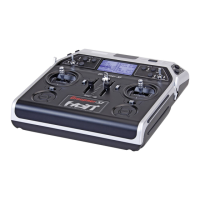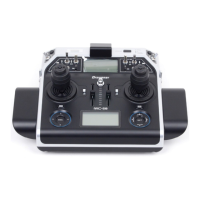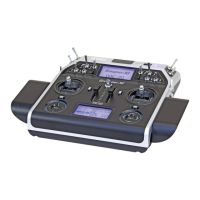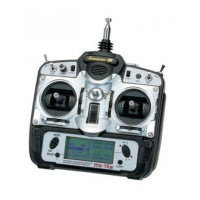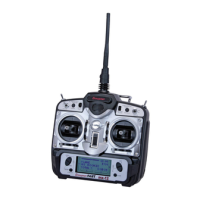56
Receiver power supply
Auxiliary function
Y-lead,
Order No. 3936.11
PRX stabilised
receiver power supply,
Order No. 4136
Auxiliary function
Y-lead,
Order No. 3936.11
PRX stabilised
receiver power supply,
Order No. 4136
For reasons of safety, do not use battery boxes or dry
cell batteries.
The voltage of the on-board power supply will be
displayed at the bottom right of the transmitter’s screen
while the model is in operation:
GRAUBELE
#01
2:22h
Stp
Flt
«normal »
K78
0:00
0:00
5.5V
3.9V
M
HoTT
If the voltage falls below the warning threshold – 3.80 V
as standard – set in the “RX SERVO TEST” display of
the “SETUP, DISPLAYS” sub-menu of the »Telemetry«
menu, page 250, then the system generates a visual
and audible low voltage warning.
Despite this feature, be sure to check the
condition of the battery at regular inter-
vals. Do not wait for the warning to be
issued before recharging the battery.
For example, from this point of view a battery with
1400 mAh would be the absolute minimum to power a
receiver system with a total of 4 analog servos. But be
sure to also consider the receiver itself into the calcu-
lation because its bidirectional functionality will draw
about 70 mA of current too.
Regardless, it is generally recommended that you con-
nect the receiver via two cables to the power supply:
cable “1” is to be as usual, plugged into the “12 + B”
port of the receiver and cable “2” at the opposite, with
“11 + B - “label, the end of the edge connector of the
receiver.
For example, by using a switch or voltage regulator
with two leading to the receiver power supply cable. If
necessary, use to connect them to the receiver a V or Y
cable No. 3936.11, see figure, if you need one or both
terminals of the receiver and to connect a servo, speed
controller etc.. They reduce by the double connection
to the switch or voltage regulator not only the risk of a
cable break, but also ensure more power to the con-
nected servos.
If a separate battery is connected to each receiver bat-
tery connection, be absolutely sure the batteries have
the same voltage and power rating. Never connect dif-
ferent battery types or batteries charged to significantly
different levels to the receiver. This can lead to effects
similar to short circuit conditions. In such cases, insert
voltage stabilizers, such as the PRX-5A receiver power
supply, between the batteries and the receiver.
Among other aspects, the safe operation of a
model depends on a reliable power supply. In
the event that, despite smooth operating rods,
fully charged battery, battery leads with adequate
cross-section, minimum contact resistances at con-
nectors, etc., the transmitter indicates repeated receiv-
er voltage collapses or is receiver voltage is generally
too low; please give attention to the following notices:
Give primary attention to fully charged batteries when
model operation is to be started. Be sure that the
contact surfaces of connectors and switches really
are low resistance. If necessary, measure the voltage
drop across installed switch cables when they are
under load because even new heavy-duty switches
can cause a voltage drop of up to 0.2 V. This value can
increase in contacts by factors as a consequence of
aging and oxidation. The constant vibrations and jarring
also takes its toll on contacts to produce a creeping
increase of contact resistance.
Servos present another possible problem source. Even
rather small servos like a Graupner/JR DS-281 can
draw up to 0.75 A of current when it is blocks under
load. Just four of these servos in a “foam” model can
therefore load down the on-board power supply by as
much as 3 A …
A further factor is that 2.4 GHz receivers generally pass
control signals to servos at a higher rate than with
comparable receivers used in earlier frequency ranges.
This equates to shorter “off” periods, which also has an
effect on the power consumption of the receiving sys-
tem. The current drain of many of today’s digital servos
is also higher, reflected by their greatly improved ability
to hold the prescribed position between control signals.
Therefore you should choose a power supply which will
not break down under greater loads but rather always
deliver sufficient voltage. To “calculate” necessary
battery capacity you should always figure on at least
350 mAh for every analog servo and at least 500 mAh
for every digital servo.
Receiver power supply

